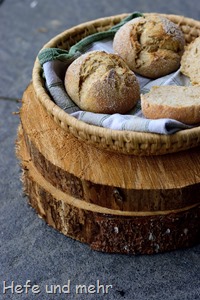 Sometimes it is just time to use leftovers. Like last friday, when I looked around in the kitchen: there was some leftover fine rye meal from the blackbread, a small bowl with mashed potatoes and in the fridge I found a lonely egg yolk. And so I combined everything and kneaded a dough for the next day. As I prefer freshly baked rolls for breakfast, the dough rose overnight in the fridge.
Sometimes it is just time to use leftovers. Like last friday, when I looked around in the kitchen: there was some leftover fine rye meal from the blackbread, a small bowl with mashed potatoes and in the fridge I found a lonely egg yolk. And so I combined everything and kneaded a dough for the next day. As I prefer freshly baked rolls for breakfast, the dough rose overnight in the fridge.
When we get up on Saturday I went straight to the kitchen and formed the rolls. And while we get ourselves ready, cooked coffee and lay out the table, the rolls proofed and got baked. And when we then had breakfast with the flavourful fluffy rolls I thought once again: leftover recipes can be so great!

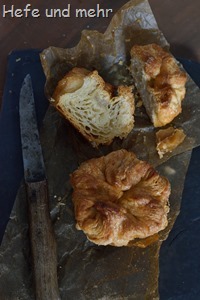 Butter is a staple in the Breton kitchen – which shows in the
Butter is a staple in the Breton kitchen – which shows in the 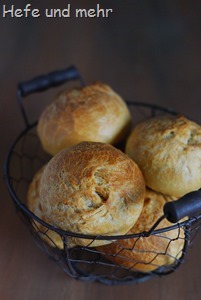 Kieler Semmeln are rolls which stem – as their name suggested – from Kiel. They are a special roll as they are rubbed in a mixture of butter and salt, which gives their surface a rough look and adds a nice buttery and sligthly salty flavour. There are different recipes around for this kind of rolls, some of the containing lard or cinnamon as well. Cinnamon seems to me a bit to adventurous for a first trial, but I keep this variant in the back of my head for a second version.
Kieler Semmeln are rolls which stem – as their name suggested – from Kiel. They are a special roll as they are rubbed in a mixture of butter and salt, which gives their surface a rough look and adds a nice buttery and sligthly salty flavour. There are different recipes around for this kind of rolls, some of the containing lard or cinnamon as well. Cinnamon seems to me a bit to adventurous for a first trial, but I keep this variant in the back of my head for a second version.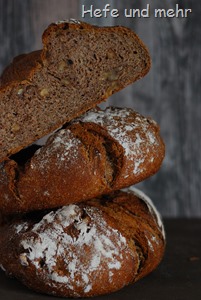
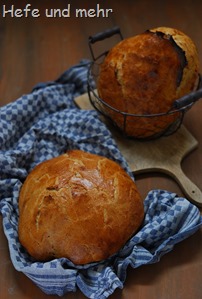 “Eingenetztes Brot” would be Net-Bread if translated literally. But the origin from the word “eingenetzt” does not stem from the German “Netz” (net) but from “Nass”, which means “Wet”. And making the bread is wet indeed. The sticky dough is easiest to handle when hands and tools are really wet. When the bread is placed in the oven its surface is wet as well. This helps to create the shiny crust which is characteristic for this bread. To get the soft dough in the oven without accident, a so called “Schapf”, a kind of ladle, is used traditionally. Even in my rather big kitchen collection, there is no “Schapf” and so I used a small salad bowl instead. And this worked fine!
“Eingenetztes Brot” would be Net-Bread if translated literally. But the origin from the word “eingenetzt” does not stem from the German “Netz” (net) but from “Nass”, which means “Wet”. And making the bread is wet indeed. The sticky dough is easiest to handle when hands and tools are really wet. When the bread is placed in the oven its surface is wet as well. This helps to create the shiny crust which is characteristic for this bread. To get the soft dough in the oven without accident, a so called “Schapf”, a kind of ladle, is used traditionally. Even in my rather big kitchen collection, there is no “Schapf” and so I used a small salad bowl instead. And this worked fine!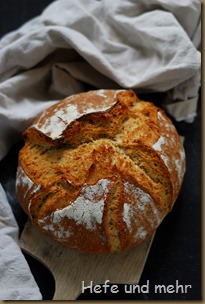 I got a lot of positive feedback to my idea of making a small virtual bread baking course. I’m very happy about it and will start to post more beginner recipes on the blog in the next weeks. And if you have questions, ideas or wishes: Please tell me! I will do my best to include it.
I got a lot of positive feedback to my idea of making a small virtual bread baking course. I’m very happy about it and will start to post more beginner recipes on the blog in the next weeks. And if you have questions, ideas or wishes: Please tell me! I will do my best to include it.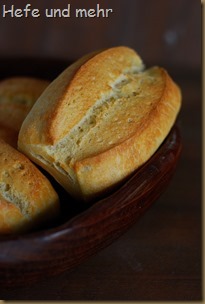
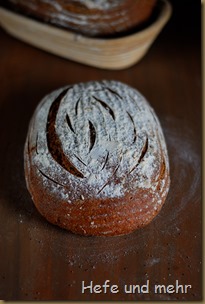
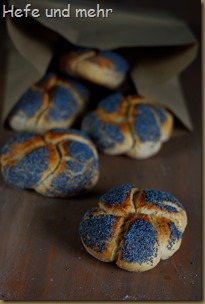 A short look through the kitchen cupboards produced a open glass of yoghurt, some boiled potatoes form our Lunch and a leftover of whole rye flour. Together with a little spoonful of sourdough (a idea I copied from Günther Weber) I kneaded them to a dough and let them rise over night. The next morning I formed and baked some rolls from this dough which rose highly while we splept.
A short look through the kitchen cupboards produced a open glass of yoghurt, some boiled potatoes form our Lunch and a leftover of whole rye flour. Together with a little spoonful of sourdough (a idea I copied from Günther Weber) I kneaded them to a dough and let them rise over night. The next morning I formed and baked some rolls from this dough which rose highly while we splept.